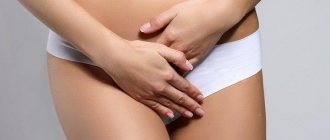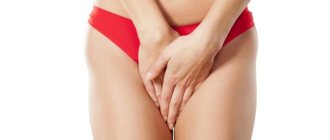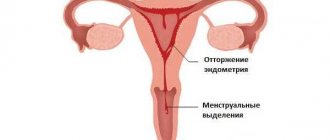Anatomy of the nipples and changes in the breast during pregnancy
Nipples are the “ends” of the breast, the outer convex parts of the mammary glands. The shape of women's nipples is individual. It can be cone-shaped (more often in nulliparous women), cylindrical, with convex or retracted nipples. They are surrounded by areolas - pigmented, rounded areas of skin. The diameter of each of them is also individual, but usually in nulliparous women it does not exceed 5 cm, and in women who have given birth it can reach 8 cm.
The nipple consists of the areola and the nipple itself; the appearance of Montgomery tubercles is also possible
With the onset of pregnancy, under the influence of hormones, the growth of gland lobules occurs. As a result, breasts and nipples:
- increase in size;
- swell;
- become more sensitive.
Under the influence of melanocytes, the pigmentation of the nipples increases - they acquire a dark brown color. Sweat glands enlarge, which leads to the formation of so-called Montgomery tubercles on the areola . They may disappear after childbirth or remain forever, which is also normal.
Nipple changes - normal variants
The breast is an organ that is extremely sensitive to hormonal changes in the body. Therefore, her condition changes during pregnancy and after childbirth. Let's take a closer look at possible changes in the nipple area, depending on the period of gestation, which are considered normal variants.
As pregnancy progresses, the areola on the breast grows and darkens.
First trimester
After successful conception, nipples may become extremely sensitive to touch. Even when wearing a bra or while running, you may experience pain . This condition usually occurs shortly before a missed period and continues for several weeks or the entire first trimester of pregnancy. Gradually, the breasts become heavier and increase in size. By the end of the first trimester, the nipples darken a little, swell significantly, and the diameter of the areola increases.
Already in the first trimester, you may need to change your underwear to softer, natural fabrics that provide safe support for your growing breasts
Second trimester
At the beginning of the second trimester of pregnancy, soreness and high sensitivity of the nipples are significantly reduced. However, the volume of the mammary glands acquired in the first trimester will remain and may subsequently increase due to an increase in the woman’s total body weight . The increased amount of blood in the body can lead to the appearance of a special lubricant on the nipples. This secretion is released from the Montgomery tubercles. They are located on the areolas of the nipples and have white “rods”.
Important: it is believed that the purpose of Montgomery tubercles is to protect the nipples from damage and dry skin, and after childbirth to attract the baby with a subtle smell.
There is no need to try to get rid of Montgomery bumps or worry about their appearance - just follow standard hygiene rules. Also, subcutaneous veins may appear on the nipples, which is also associated with an increase in the volume of circulating blood in the body. It is possible that already at this stage, colostrum - a translucent or yellowish thick liquid - will begin to be released from the nipples.
It is forbidden to try to express colostrum - this can lead to uterine contractions, miscarriage or premature birth . If there is too much colostrum, then use nursing pads that are inserted into the bra. The absence of discharge is not considered a deviation - the secretion may not be discharged from the nipples at all throughout pregnancy. Darkening of the areolas is also considered normal.
Bra pads come in different thicknesses, disposable and reusable
Third trimester
In the third trimester of pregnancy, breast volume increases to the maximum - it usually becomes 1-2 sizes larger compared to the pre-pregnancy period. The nipple areolas reach their maximum volume, and the tips are slightly pulled forward, preparing for upcoming breastfeeding. Hyperpigmentation occurs - the nipples darken and acquire a dark brown color. Due to the rapid growth of tissue, itching may be felt. The closer the due date, the greater the likelihood of colostrum appearing from the nipples.
The volume of secretion released from the breast varies from person to person.
When the amount is minimal, colostrum accumulates directly on the tips of the nipples, forming a yellowish thick coating. It is possible that the colostrum will ooze or drip - expressing it is still not recommended. In the third trimester, the sensitivity of the nipples decreases somewhat - this is how nature takes care of the woman, protecting her from painful sensations when the baby sucks at the breast after childbirth. However, it is not always possible to avoid them, especially for those who become mothers for the first time. Flat, inverted nipples protrude slightly toward the end of pregnancy. For flat nipples, you can use special devices for traction at first or silicone breast pads to make breastfeeding easier.
If at the time of birth the nipples remain retracted, a special device that pulls out the nipple like a syringe will help to establish breastfeeding
In some women, the nipples hardly change during pregnancy, while stable lactation is established after childbirth. Characteristic changes can occur partially in a particular woman, be strong or mild. In rare cases, pigment spots and papillomas may appear on the nipples. Such formations require specialist supervision.
The main hormones that influence the restructuring processes occurring in the mammary glands during pregnancy are human chorionic gonadotropin (synthesized by the placenta), prolactin and the hormone of the corpus luteum - progesterone. After childbirth, a woman’s body, under the influence of prolactin, secretes milk, the secretion of which involves insulin, cortisol and the pituitary hormone oxytocin. By the end of the 5th–8th week of pregnancy, the mammary glands of many women noticeably increase in size, become heavier, the pigmentation of the areola increases, and the superficial veins dilate. The process of preparing the breast for lactation continues until childbirth. In the second half of pregnancy, women may notice the spontaneous release of droplets of colostrum from the nipples, which is a normal physiological process that should not cause any concern.
Popadinets Maria Vasilievna, mammologist-oncologist, homeopath
https://mammolog.in.ua/sitemap/70/
When to be wary
During pregnancy, it is especially important to take care of your breasts, avoid hypothermia, and rubbing your nipples with underwear. It is worth visiting a mammologist to make sure there are no cysts, neoplasms, or tumors in the mammary glands. If any problems are detected, this doctor should monitor the woman throughout the entire pregnancy.
Ultrasound of the mammary glands is performed using ultrasound beams. This diagnostic method is absolutely safe and is recommended for all patients aged 20 years and older, including pregnant and lactating women. Ultrasound examination allows detailed visualization of lymph nodes and identification of metastases. In addition, the capabilities of ultrasound make it possible to conduct Doppler measurements of the mammary glands, that is, to study the blood flow in the breast for a comprehensive diagnosis of malignant and benign neoplasms.
radiologist, mammologist Ivan Smirnov
https://www.sncmedia.ru/body/12-voprosov-o-zdorove-grudi-otvechaet-vrach-mammolog/
We list the symptoms that should alert you and become a reason to contact a medical facility:
- swelling, hardening of the breast, accompanied by high body temperature (possible development of mastitis);
- inflammation of the Montgomery tubercles - redness, dark spots on the nipples, etc.;
- sharp lightening of the nipple areolas (possible circulatory problems or frozen pregnancy);
- discharge from the nipples with an unpleasant odor or an unusual color - brown, bloody, pink, greenish (inflammation in the chest);
- the appearance of crusts, cracks, areas of peeling on the nipples;
- sharp pain in the nipple area;
- different colors of the nipples, their differences in diameter or color of the areola (the presence of a benign or malignant formation in the mammary gland is possible).
If the condition of the breast gives rise to concern, the doctor will prescribe an ultrasound
I would especially like to highlight the topic of mastitis. There is a false belief that it only occurs in nursing mothers. Mastitis can occur at any age. In newborn children (usually girls), adolescents, during pregnancy, during breastfeeding, after abortion, during hypothermia, and even during menopause. Rarely, mastitis in men also occurs. Attention! During pregnancy and lactation, it is important to keep your breasts warm, away from drafts, and away from air conditioners.
Popadinets Maria Vasilievna, mammologist-oncologist, homeopath
https://mammolog.in.ua/sitemap/70/
Pain and discomfort in the nipples
The nature and intensity of pain in the nipple area can manifest itself in the form of:
- aching pain;
- pain from touch;
- pain from chest shaking during movements;
- burning;
- itching, etc.
All of these sensations can be normal or dangerous. Therefore, the expectant mother needs to tell the doctor about them.
Cracks, inflammation, sharp pain in the nipples require medical attention
How to reduce the pain of discomfort in the chest
The following ways can help reduce pain:
- wearing comfortable underwear. Already at the beginning of pregnancy, it is worth purchasing a bra of a larger size than before, made of natural materials and internal seams. It is advisable that its straps be wide - such models reduce vibrations of the nipples during body movements. It is recommended to sleep in a cotton top that supports your breasts. The bra should not put pressure on the chest or rub against the nipples. It is worth giving preference to a bra with a soft inner surface of the cups that fits tightly to the nipples. It is advisable to purchase special underwear for expectant mothers;
- water procedures and air baths. A contrast shower will help reduce pain. Alternate the water temperature from slightly cooler to warmer. This technique will improve blood circulation and reduce discomfort in the mammary glands. After a shower, gently dry your skin and let your breasts “breathe” until they dry completely, and only then put on your underwear;
- taking vitamins. Due to lack of nutrients and excessive tension, the skin of the nipples can become quite dry, begin to peel and itch. In the worst case, cracks and inflammation may appear on the nipples. It is recommended to take multivitamins for expectant mothers containing A and E, and Folic acid.
To prevent cracked nipples, the diet should be rich in foods with vitamins A and E
Possible pathologies
Sometimes, discharge from the breast during pregnancy indicates the presence of pathologies in the body of the expectant mother. These include the following violations:
- galactorrhea;
- ectasia of the milk ducts;
- mastitis;
- mammary gland trauma;
- fibrocystic mastopathy;
- mammary cancer.
These pathologies can cause discharge from the mammary gland. These are quite serious diseases that need to be treated.
Nipple care during pregnancy
You should not try to organize increased nipple care during pregnancy. On the contrary, the less manipulation you do with this sensitive area, the better. The fact is that at the physiological level, nipples are associated with the contractile activity of the uterus. The body perceives their excessive stimulation as a signal to cleanse the uterine cavity by contracting it.
Be careful: overstimulation of the nipples causes uterine contractions
During pregnancy this can lead to:
- hypertonicity;
- miscarriage;
- premature birth.
Normally, the newborn stimulates the nipples while sucking milk, giving the body a signal - childbirth has occurred, it is necessary to reorganize work, contract the uterus, and prepare for the next pregnancy. For the same reason, modern experts call for abandoning rubbing the breasts with a towel in an effort to “prepare” the nipples for feeding before childbirth.
Do not try to wash and rub your nipples frequently
At any stage of pregnancy, for hygiene purposes, it is enough to lightly wet the nipples with a soft towel dipped in warm water, cleansing the skin. This should be done no more than twice a day. It is recommended to use soap as little as possible, as this product washes away the protective lubricant from the nipples and causes dry skin. When colostrum appears, clean the breasts with a damp towel as needed.
Important: if the expectant mother is bothered by itching or dry nipples, then in the absence of allergies, it is permissible to lubricate the affected areas with special creams for expectant mothers, enriched with panthenol and vitamin E. They will moisturize the skin, relieve itching, and eliminate excessive dryness. If irritation does not go away, consult a doctor.
You should not try to “stretch” flat nipples during pregnancy. When breastfeeding, they will take on the most comfortable shape.
What not to do:
- intensively massage and rub the nipples;
- smear them with green paint;
- let your spouse or other people breastfeed;
- scratch your nipples;
- express colostrum;
- squeeze out Montgomery tubercles;
- harden and supercool nipples.
Colostrum
Yellow discharge from the mammary glands during pregnancy is colostrum. Usually, this watery, sweetish-tasting liquid appears immediately after the birth of a child and serves as the first food for the baby. But sometimes colostrum is also released during pregnancy, starting from the 19th week. There is no need to worry about this, as this is a normal process.
Initially, colostrum is thick and yellow, but closer to childbirth, the discharge becomes discolored and becomes more liquid. Under no circumstances should you express it, as this will trigger the release of oxytocin, which is dangerous for the body of a pregnant woman.











